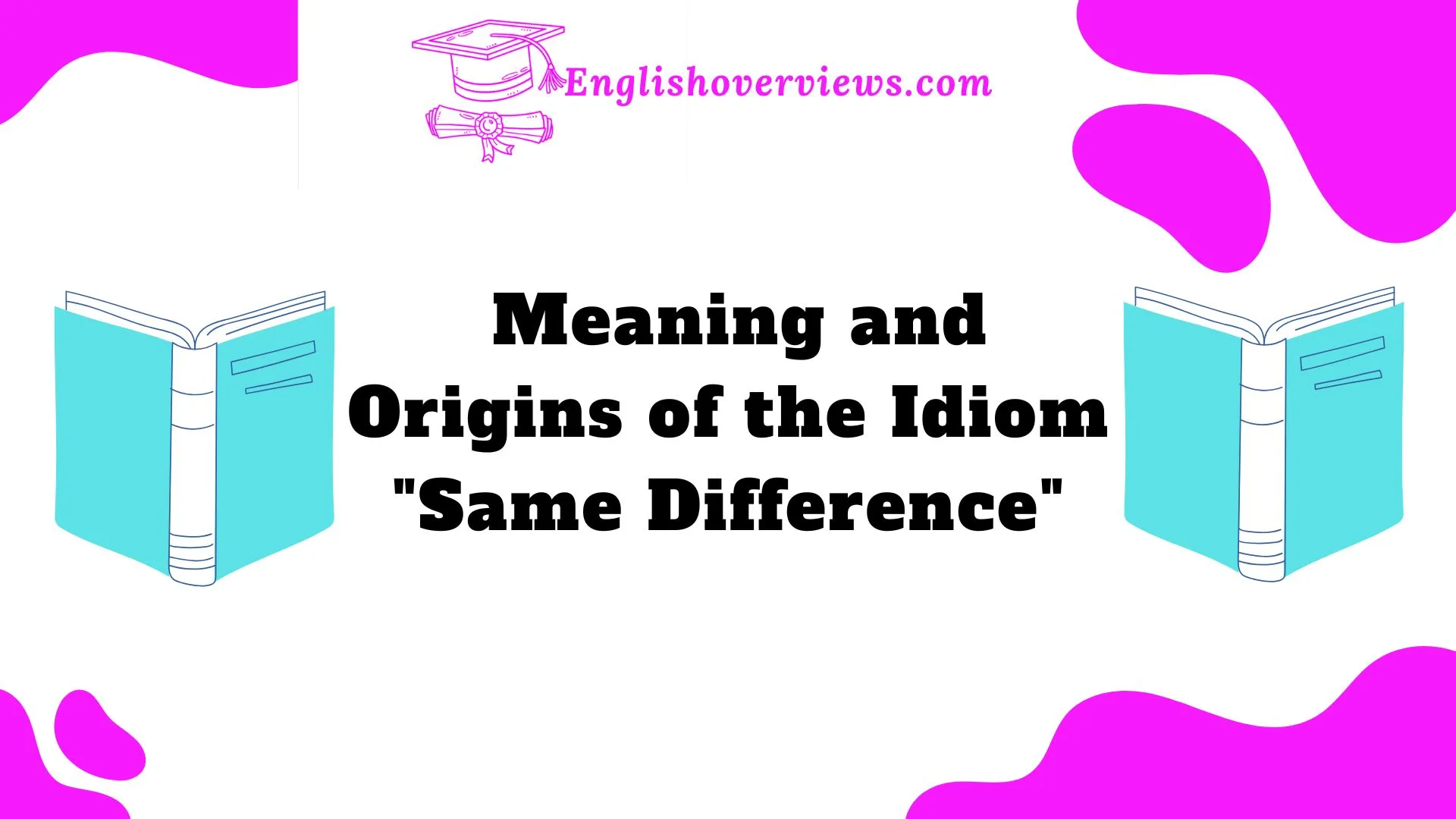Understanding idioms can sometimes feel like cracking a code. They add flair and personality to language, but they can also confuse those unfamiliar with their roots or meanings. One idiom that often sparks debate is “same difference.”
You’ve probably heard someone say, “It’s the same difference” when comparing two things that, in their eyes, aren’t truly different at all. But have you ever wondered where this phrase came from, why it’s used, or what it really means?
In this post, we’ll unpack the meaning of “same difference” and dive deep into its historical roots. We’ll explore its evolution and common uses in everyday conversations. Along the way, we’ll look at similar idiomatic expressions and provide real-life examples.
Plus, we’ll break it down in simple, easy-to-understand terms to ensure you’re ready to confidently use this phrase in your own conversations. So, tune in!
Understanding the Idiom “Same Difference”
What Does “Same Difference” Mean?
At first glance, the phrase “same difference” might seem like a contradiction. After all, “same” and “difference” don’t usually go hand in hand. Yet, it’s used quite often in casual conversation.
The phrase is typically used to express that two things, although slightly different in appearance or detail, ultimately result in the same outcome or effect. For instance, when comparing two options that lead to the same result, you might hear someone say, “It’s the same difference.” This is shorthand for acknowledging that while the details may vary, the result remains unchanged.
Common Situations Where “Same Difference” Is Used
- Debates Over Minor Differences: When two people are arguing about two options that are fundamentally the same.
- Example: “We can go left or right, it’s the same difference.”
- In the Workplace: Discussing strategies or choices that may appear different but achieve the same goal.
- Example: “Whether we go with the new design or tweak the old one, it’s the same difference-both will work.”
- Social Gatherings: Casual conversations where people might disagree on small things, but both are ultimately indifferent.
- Example: “I’ll have coffee, you’ll have tea-same difference!”
The Historical Roots: Tracing the Origin of “Same Difference”
Where Did “Same Difference” Come From?
The exact origin of “same difference” is somewhat unclear, but it’s widely believed to have emerged in the early 20th century, most likely in American English.
The phrase likely grew from the desire to express resignation or acceptance when discussing two things that are technically different but have little to no practical difference.
Many idiomatic expressions, like “same difference,” evolved from everyday speech, often without formal documentation. While we may not know the exact moment this phrase entered common use, it’s clear that it stuck because it’s a concise way to express indifference about small differences.
First Recorded Uses
- The first known recorded instances of “same difference” appeared in the 1920s, showing up in popular culture, and later, it became ingrained in American slang. It’s thought that the idiom was initially used more informally, in spoken language, before being picked up in written form.
The Evolution of Idiomatic Expressions in American English
The Rise of Idioms in Everyday Language
Idioms like “same difference” didn’t just spring up overnight. They’re part of a long tradition of expressive language in American culture. As the English language evolved in the U.S., so did the way people spoke. Many of these idiomatic phrases emerged from regional dialects and colloquial speech.
In fact, American English has been a melting pot of idioms, heavily influenced by various cultures and communities. From Native American languages to European settlers’ vernacular, many idioms were adopted and evolved over time, shaping the way English speakers communicate today.
How Idioms Reflect Cultural Shifts
The way people use idiomatic expressions often reflects social changes and attitudes. For example, phrases like “same difference” convey a sense of practicality-acknowledging that small details don’t matter as much as the bigger picture.
In the fast-paced, results-driven culture of modern America, this phrase is a reminder to focus on the outcome, rather than getting bogged down by small variations.
Deconstructing the Phrase: Why “Same Difference” Makes Sense (and Doesn’t)
Breaking Down the Paradox
Let’s take a closer look at the phrase itself. The two words “same” and “difference” seem to be contradictory, don’t they? It’s almost like saying, “It’s the same difference, but also not the same.” It’s this paradox that makes the phrase so intriguing.
The real meaning behind it is that while two things may be different in appearance or detail, the outcome or result is the same. This contradiction is what makes the phrase effective in everyday speech-it expresses a subtle dismissal of minor differences, focusing instead on the larger context.
Why People Use Contradictory Phrases
Humans are often drawn to paradoxes and contradictions because they add flavor to communication. These phrases often communicate emotions or opinions in a way that’s more nuanced than a straightforward statement would. “Same difference” acknowledges a small discrepancy but emphasizes that it’s not important enough to make a real impact.
Real-Life Examples of “Same Difference” in Everyday Conversation
Scenario 1: Casual Conversations
Imagine a group of friends discussing what movie to watch. One person suggests an action film, while another proposes a comedy. Someone else might say, “It’s the same difference-both are fun!” Here, they’re expressing that both options will deliver a similar experience, so it doesn’t matter which one they choose.
Scenario 2: Workplace Discussions
In the office, two colleagues might debate whether to take one approach or another for a project. One might suggest, “We could use the old system, or we could switch to the new tool, but it’s the same difference-the project will be done either way.”
Scenario 3: Family Debates
In a family setting, two siblings might argue over which restaurant to go to for dinner. One says, “Let’s go to Italian,” while the other says, “I’d prefer Chinese.” A third might respond, “Same difference, we’re getting takeout anyway!”
Similar Idiomatic Expressions That Reflect a Paradox
There are several idioms that, like “same difference,” express similar sentiments. Here are a few:
1. “Six of One, Half a Dozen of the Other”
This idiom means that two things are essentially the same, even if they appear to be different. It’s often used when people argue about which option is better when the choices are equally valid.
2. “It Is What It Is”
This phrase acknowledges that a situation can’t be changed, and there’s no use in overanalyzing it. It’s similar to “same difference” in the sense that it expresses resignation or acceptance.
3. “You Say Tomato, I Say Tomahto”
This idiom is a playful way to say that two people are arguing over something trivial. It emphasizes that despite slight differences, the result is the same.
Conclusion: Why “Same Difference” Is Here to Stay
The Lasting Power of “Same Difference”
“Same difference” has become a staple of modern speech. It serves as a concise, easy-to-understand way to express indifference toward minor details. Its simplicity is part of its charm, and it has successfully endured for decades.
Whether you’re in a casual conversation or navigating a more formal setting, the idiom provides a quick way to say, “This doesn’t matter that much,” while keeping the conversation moving forward.
Cultural Relevance
In a world where we often focus on efficiency and results, idioms like “same difference” remind us that sometimes, the specifics don’t matter. It’s the end result that counts, and that’s what we should focus on.
FAQs
1. What does “same difference” mean in simple terms?
It means that two things are essentially the same, even though they may appear different at first glance.
2. Where did the phrase “same difference” come from?
It likely originated in American English in the early 20th century, reflecting a casual way of expressing that two things are ultimately the same.
3. Is “same difference” formal or informal?
It’s an informal expression, used mostly in casual conversation.
4. Can I use “same difference” in professional settings?
While it’s best suited for informal settings, it can be used in a lighthearted or casual tone in professional discussions, especially when discussing small, unimportant differences.
5. What are other expressions similar to “same difference”?
Similar expressions include “six of one, half a dozen of the other,” “it is what it is,” and “you say tomato, I say tomahto.”
Conclusion
This blog post provides an in-depth exploration of the idiom “same difference,” examining its meaning, historical roots, and evolution in language. By breaking it down with real-life examples, we’ve made sure you can use it confidently and understand why it’s still relevant in conversations today. Embrace the charm of idioms and keep them in your linguistic toolkit!

English Overviews is a resourceful website dedicated to providing valuable content related to grammar and vocabulary. AD has made notable contributions, sharing insights on various subjects, including WordPress themes and plugins. The primary goal of the site is to help users improve their English language skills effectively.











